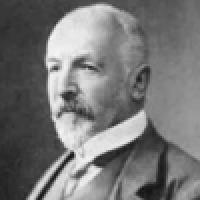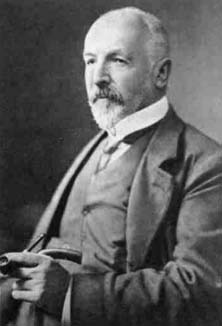
Maths in a minute: Counting numbers

Georg Cantor
Are there more irrational numbers than rational numbers, or more rational numbers than irrational numbers? Well, there are infinitely many of both, so the question doesn't make sense. It turns out, however, that the set of rational numbers is infinite in a very different way from the set of irrational numbers.
As we saw here, the rational numbers (those that can be written as fractions) can be lined up one by one and labelled 1, 2, 3, 4, etc. They form what mathematicians call a countable infinity. The same isn't true of the irrational numbers (those that cannot be written as fractions): they form an uncountably infinite set. In 1873 the mathematician Georg Cantor came up with a beautiful and elegant proof of this fact. First notice that when we put the rational numbers and the irrational numbers together we get all the real numbers: each number on the line is either rational or irrational. If the irrational numbers were countable, just as the rationals are, then the real numbers would be countable too — it's not too hard to convince yourself of that.
So let's suppose the real numbers are countable, so that we can make a list of them, for example 1. $0.1234567\dots$ 2. $1.4367892\dots$ 3. $2.3987851\dots$ 4. $3.7891234\dots$ 5. $4.1415695\dots$ and so on, with every real number occurring somewhere in the infinite list. Now take the first digit after the decimal point of the first number, the second digit after the decimal point of the second number, the third digit after the decimal point of the third number, and so on, to get a new number $0.13816\dots$. Now change each digit of this new number, for example by adding $1$. This gives the new number $0.24927\dots$. This new number is not the same as the first number on the list, because their first decimal digits are different. Neither is it the same as the second number on the list, because their second decimal digits are different. Carrying on like this shows that the new number is different from every single number on the list, and so it cannot appear anywhere in the list.But we started with the assumption that every real number was on the list! The only way to avoid this contradiction is to admit that the assumption that the real numbers are countable is false. And this then also implies that the irrational numbers are uncountable.
It's easy to see that an uncountable infinity is "bigger" than a countable one. An uncountable infinity can form a continuum, such as the number line, in a way that a countable infinity can't. Cantor went on to define all sorts of other infinities too, one bigger than the other, with the countable infinity at the bottom of the hierarchy. When he first published these ideas, Cantor faced strong opposition from some of his colleagues. One of them, Henri Poincaré, described Cantor's ideas as a "grave disease" and another, Leopold Kronecker, went so far as to denounce Cantor as a "scientific charlatan" and "corrupter of youth". Cantor suffered severe mental health problems which may have resulted in part from the rejection his work had met with. But we now know that his work had simply come too soon: 150 years on, Cantor's ideas form a central pillar of mathematics and many of his results can be found in standard textbooks.
See our infinity page to find out more about this and other things to do with infinity.
Anonymous
In our base-ten system, there is a range of square numbers, 1,4,9,16,25 etc. Of these very many consist of a mixture of odd and even digits. Is this subset countable? There is a much smaller subset, 4, 64, 400, 484, etc, which consists of only even digits. Is this countable? And there is a very special subset which is definitely countable, consisting of the squares with only odd digits - 1 and 9. As far as I can see, there is no relationship between these subsets, except that they add together to the "master"set.
Leslie.Green
According to mathematicians who follow Cantor's idiocy, the set of all square numbers is the same size as the set of counting numbers. In fact they go even further and declare that the set of rational numbers is the same size too. They have a fundamental problem with their definition of the infinity symbol. By declaring that twice infinity is the SAME infinity, they can't actually compare the sizes of different infinite values. Consider some value N which we will soon increase towards infinity. N² is much bigger than N, which is bigger than sqrt(N), which is bigger than log10(N). Put N = 10^10. N² has 19 digits, N has 10 digits, log10(N)=10. These values do no get closer as we approach infinity, they diverge more. It is useful to compare different infinites and they have set themselves up to fail.
It's time we ditched this Cantor-induced insanity: http://lesliegreen.byethost3.com/articles/new_maths.pdf
max
I looked at your enumeration of the continuum and it appears that you have enumerated only the terminating decimals (equivalently decimals that end in infinite trailing zeros or 9's). You have not enumerated all of the real numbers. If we focus on the enumeration of [0, 1) , how does your list produce the real number 1/3 = 0.333...? This real number is not a terminating decimal (nor does it end in infinite trailing zeros or nines). It will never be in the list - even if you are given an infinite amount of time to list numbers. Said another way, the real number 1/3 is not in the 'eventually-we-will-get-there' list, since your enumeration or listing method has no way of producing 0.333..., it is not in the list at all. A similar argument can be made for √2, but I will use 1/3 as a simpler counterexample.
max
I looked at your enumeration of the continuum and it appears that you have enumerated only the terminating decimals (equivalently decimals that end in infinite trailing zeros or 9's). You have not enumerated all of the real numbers. If we focus on the enumeration of [0, 1) , how does your list produce the real number 1/3 = 0.333...? This real number is not a terminating decimal (nor does it end in infinite trailing zeros or nines). It will never be in the list - even if you are given an infinite amount of time to list numbers. Said another way, the real number 1/3 is not in the 'eventually-we-will-get-there' list, since your enumeration or listing method has no way of producing 0.333..., it is not in the list at all. A similar argument can be made for √2, but I will use 1/3 as a simpler counterexample.
math.nights
To Arabic: https://goo.gl/LTmQUn